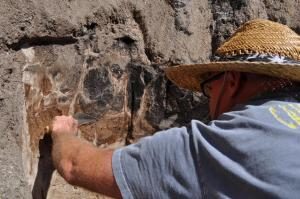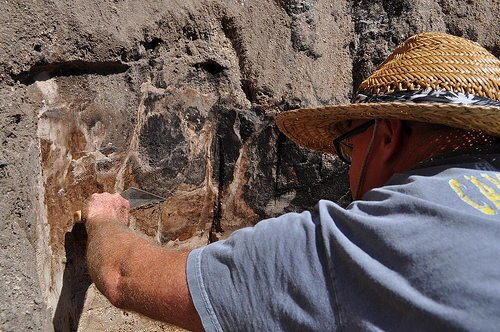
FLORIDA ATLANTIC UNIVERSITY—In what is considered one of the oldest and most important archaeological digs in North America, scientists have uncovered what they believe are the bones of a 13,000- to 14,000-year-old ancient, extinct species of bison at the Old Vero Man Site in Vero Beach, Fla. Archaeologists from Florida Atlantic University’s Harbor Branch Oceanographic Institute made this discovery just 10 feet below the ground’s surface during the final stretch of the 2016 excavation efforts at the Vero Beach site.
The bone was found below a layer that contained material from the Pleistocene period when the last ice age was thought to have occurred. The archaeologists identified the bison using an upper molar, which is thought to be representative of a Bison antiquus, a direct ancestor of the American bison that roamed North America until it became extinct. Because bison was a grassland-adapted animal, nearly 100 percent of their bones disintegrated after death unless they were preserved in some way.
“This finding is especially significant because of the meticulous documentation that has been involved,” said James M. Adovasio, Ph.D., principal investigator. “Along with the fact that bones like this have never been found on land as part of a calculated archaeological effort. Others like this have all been found underwater, in sinkholes or streams.”
______________________________________
In what is considered one of the oldest and most important archaeological digs in North America, scientists have uncovered what they believe are the bones of a 13,000- to 14,000-year-old ancient, extinct species of bison at the Old Vero Man Site in Vero Beach, Fla. Credit: Harbor Branch Oceanographic Institute, Florida Atlantic University
______________________________________________________
Bison antiquus, sometimes referred to as the “ancient bison,” was the most common large herbivore of the North American continent for more than 10,000 years, and is a direct ancestor of the living American bison. They were approximately 8 feet tall, 15 feet long and weighed close to 3,500 pounds.
“We couldn’t have asked for a better representative species from that era,” said Andrew Hemmings, Ph.D., lead archaeologist. “We now know that people were here in Vero Beach at that time.”
The bones of the ancient bison have been moved to FAU’s Ancient DNA Lab at Harbor Branch for further research and examination. The lab was established in 2011 to investigate the population biology, genetic diversity and species composition of past ecosystems.
Scientists also found other bones at the site from small mammals, along with slivers of bones from large mammals that could have come from mammoth, mastodon, sloth or bison. Pieces of charcoal and the head of a fly were discovered earlier in this year’s excavation, which began in late February.
The Old Man Vero Site was originally discovered in 1915 after construction efforts on a drainage canal exposed the well-preserved remains of late Pleistocene flora and fauna in association with human remains and artifacts.
Source: News release of the Florida Atlantic University.
_____________________________________________________
The archaeological dig was led by Harbor Branch and FAU’s Department of Anthropology within the Dorothy F. Schmidt College of Arts and Letters, in partnership with the Old Vero Man Ice Age Sites Committee (OVIASC).- FAU –
_____________________________________________________

______________________________________________
Travel and learn with Far Horizons.
____________________________________________
This richly illustrated issue includes the following stories: Recent findings shedding new light on the whereabouts of the remains of Philip of Macedon, father of Alexander the Great; how an archaeologist-sculptor is bringing bones of the dead back to life; archaeologists uncovering town life at the dawn of civilization; an exclusive interview with internationally acclaimed archaeologist James M. Adovasio about what makes the Meadowcroft Rockshelter prominent in the ongoing search for the first Americans; what archaeologists are finding at the site of the ancient city of Gath, the home town of the biblical Philistine giant, Goliath; and how scientists are redrawing the picture of human evolution in Europe. Find it on Amazon.com.








